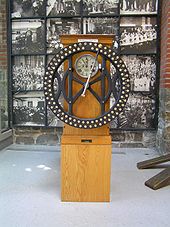Time clock

A time clock, sometimes known as a clock card machine or punch clock or time recorder, is a mechanical (or electronic) timepiece used to assist in tracking the hours an employee of a company worked. In regards to mechanical time clocks this was accomplished by inserting a heavy paper card, called a time card, into a slot on the time clock. When the time card hit a contact at the rear of the slot, the machine would print day and time information on the card. This allowed a timekeeper to have an official record of the hours an employee worked to calculate and pay an employee.
History




The first time clock was invented in November 20, 1888, by Willard Bundy, a jeweler in Auburn, New York. A year later his brother, Harlow Bundy, organized the Bundy Manufacturing Company, [1] and began mass producing time clocks. Bundy Manufacturing, along with two other time equipment businesses, was consolidated into the International Time Recording Company (ITR). [2][3] In 1911 ITR and two other companies were merged, forming Computing Tabulating Recording Corporation (CTR), which would later change its name to IBM. In 1958 IBM's Time Equipment Division was sold to the Simplex Time Recorder Company. The time cards usually had the workdays and time in and time out areas marked on them so that employees could "punch in" or "punch out" in the correct place. The employee was responsible to line up the correct area of the card to be punched with an indicator on the time card. Software applications offer such a system.
The first punched-card system to be linked to a Z80 microprocessor was developed by Kronos Incorporated in the late 1970s and introduced as a product in 1979. In the 1990s, time clocks started to move away from the mechanical version to computer based, electronic time tracking systems. On these systems, the employee either enters an employee number, swipes a magnetic stripe card, or brings an RFID tag into proximity with a reader, or uses some other device to identify the employee to the system. Based on the system being used, the employee then enters what should be recorded. This could be "punching in", "punching out", lunch breaks, reason for leaving early, or any other type of information the employer requires.
Many of the more modern time clocks, such as biometric and card swipe clocks, are capable of exporting data to a computer for use with payroll software.
Biometrics
Biometric time clocks are a class of employee time clock that uses a persons biological attributes to identify them, rather than using a card or some other external device. Examples of this are the hand print clock, which detects the overall attributes of a person's hand, fingerprint clock, and retina scanning clock. Biometric time clocks help cut down on fraud, such as buddy punching, in which an individual clocks in on behalf of another person.
Software
Software-based time clocks allow an individual, or employee, to clock in and out of work by means of a computer. No external time recording devices are required. Software time clocks vary in functionality. Some systems can only be used on one centralized computer, where other "network" packages can be used on an entire computer network. [4]
See also
External links
- IBM Time Clocks (PDF files)
- National Museum of American History: International Dial Time Recorder Clock
- Industrial Time Recorders - Chapter 175 of the National Association of Watch and Clock Collectors (NAWCC)
- www.timerecorder.de/ (mostly in German, but partly translated into English) is one of the most comprehensive online documentations of the history of time recorders and time clocks
- Harlow Bundy's home in Binghamton, it was restored and now houses a museum dedicated to the Bundys.
